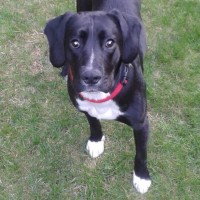Appearance of the Boxspring
|
| The Boxspring strongly resembles the Boxer in appearance. This loving dog is a medium to large breed with a muscular build. Their expression exudes confidence and elegance. Its brown eyes are generally sad, similar to those of an English Springer Spaniel. The short, silky, fine coat is non-water repellent. Color combinations range from red and brown to black and gold. Boxspring ears are soft, but not as short as Boxer ears. They are also placed on the sides of the head. The longer muzzle can be attributed to the dominant features of the English Springer Spaniel. Its long tail hangs below. The Boxspring's weight varies from 9 to 27 kilos, and it stands between 53 and 63.5 centimeters tall. |
Temperament of the Boxspring
|
| The Boxspring's energy levels are considered moderate compared to other breeds. Although it's a lively breed, it's also considered a docile dog that would be more than happy to take a brisk walk with you to the corner. The Boxspring works well with its owners and will comply with commands as long as it receives the appropriate training. This breed is not recommended for young children. Its parent breed, the English Springer Spaniel, is known to suffer from rabies syndrome, which can lead to unprovoked aggression towards anyone. For this reason, it's not known what traits the Boxspring may or may not inherit from its parents. This otherwise affectionate breed does well with other dogs and animals as long as early training is provided. It can accept and welcome strangers as long as it learns to distinguish friendly strangers. This breed is easy to train and likes to be able to follow commands. Positive reinforcement is highly recommended to prevent his stubborn ways from getting through. |
Needs and activities of the Boxspring
|
| The Boxspring has moderate energy levels and should be provided with the appropriate amount of exercise per day. Recommended exercise should last between 30 and 40 minutes a day, with around two walks a day being the minimum. Other activities such as retrieving, agility training and running can also benefit your dog. Apartment living is acceptable as long as your dog can exercise outdoors. An ideal home for your Boxspring would be a medium-sized house in an urban or rural environment with a fenced yard and a warm climate. If provided with the right amount of exercise, your adorable dog will shower you with affection. |
Maintenance of the Boxspring
|
| The Boxspring is not considered a hypoallergenic breed and will shed moderately. This breed requires daily brushing with a firm bristle brush to remove loose hair and tangles, and to avoid hair build-up around the house. Avoid bathing him too often, as this can lead to overproduction of oils on the skin; every two months should suffice. Teeth should be brushed weekly to prevent tartar build-up, as plaque build-up can lead to periodontal disease. Nails should be trimmed or filed every 2 to 3 weeks. It's advisable to start trimming nails at an early age, so that your Boxspring can get used to the grooming process. Ears should be cleaned once a week to prevent wax build-up. |









 English (United Kingdom)
English (United Kingdom)